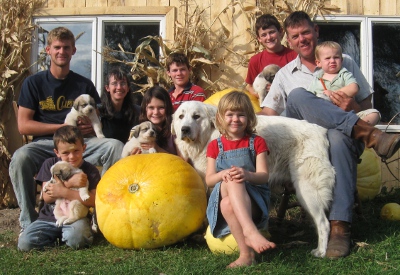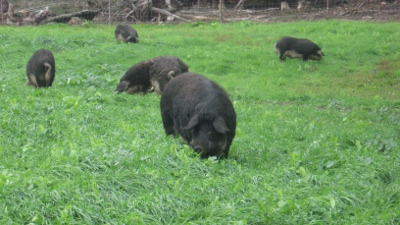Michigan Department of Natural Resources Threatens Livelihood of Over 2000 Pasture-Based Farms
by Kimberly Hartke
The Michigan Pork Producers Association is endorsing a radical move on the part of the Michigan Department of Natural Resources (DNR). The DNR has declared feral pigs, an “invasive species.” Under their interpretation any domestic pig can be considered feral. The DNR is putting fine dining chefs and the farmers who supply them on notice. Heritage breed pigs may soon be off the menu, and prohibited on pasture-based farms. Also affected, will be the many Michigan families who choose to buy humanely raised meat for their family table.
Mark Baker, retired military, nearly signed a contract to become an industrial hog farmer. That all changed when he heard Joel Salatin of Polyface Farm speak. Joel is a Virginia farmer and author of the new book, Folks, This Ain’t Normal: A Farmer’s Advice for Happier Hens, Healthier People, and a Better World![]() .
.
Inspired, Mark laid aside the CAFO contract, and decided to start a traditional farm, where chickens and hogs run free on lush pasture land. His oldest son was 7 at the time. Today, Mark and his wife Jill have 8 children.
Everyone in the Baker family pitches in to help tend to the animals. Even the 8-month-old is with his mother in an over-the-shoulder baby carrier, as she does her farm chores.
A Father Aspires to Build Character in his Children
Mark’s desire to start a farm came from his fellow soldiers in the U.S. Air Force. “The best people I worked with were farm kids. To make my children whole adults, I wanted to give them the farm kid advantage.”
“Military life is rigorous. Farm kids could keep a smile on their face and maintain a good attitude during the worst of times. They really are the salt of the American Spirit,” enthuses Mark.
Five years later, half of his farm revenue comes from pork sales. Baker’s Green Acres farm raises a special heritage breed of hog, the Mangalitsa. This breed has dark red meat and a heavy layer of fat to keep them warm in Michigan’s harsh winter weather.
Mark tills the pig fields and sows their fodder, turnips, mangals (similar to beets), field peas, and pumpkins. He has a friend in Traverse City who grows 1500-pound pumpkins for competition. Mark puts his friend’s seeds in the field and grows pumpkins to 500-pound size. The pigs can’t get their mouths open wide enough to eat them.
That is where the Baker kids get to have some good old farm fun. Their task is to go into the fields and smash the pumpkins to pieces, so that the pigs can feast.
Mark’s primary customers are fine dining chefs and charcuterie artisans in nearby Traverse City. Detroit Chef, Brian Polcyn, author of Charcuterie: The Craft of Salting, Smoking, and Curing, is also one of the farm’s patrons.
Watch this Video of Mark Baker
Regulators Sling Mud at Outdoor Pig Farms, Threaten the Livelihood of Many
The Michigan Department of Natural Resources (DNR) has declared pigs with the characteristics of heritage breeds to be feral, and an “invasive species.” As of April 1, 2012, according to an Invasive Species Order (ISO) issued by DNR, the 2000+ traditional Michigan farms such as Mark’s are in jeopardy.
According to Baker, by definition, a feral pig is a wild pig or one that has escaped the husbandry of humans and re-wilded.
The Department of Natural Resources purview is public hunting land and the agency is responsible for issuing hunting and fishing licenses. At first glance, it appears they are concerned about loose pigs running wild across public and private lands and causing property damage or threatening people. It even seems their own document exempts pigs raised on farms from this new ruling. As it turns out, the only pigs raised on farms that could be exempted are the pigs in confined animal feeding operations (CAFOs). It’s no coincidence the Michigan Pork Producers Association supports the swine ISO.
The DNR declared the following breeds of swine prohibited: “Wild boar, wild hog, wild swine, feral pig, feral hog, feral swine, Old world swine, razorback, eurasian wild boar, Russian wild boar (Sus scrofa Linnaeus).”
As Mark explains, the use of the terminology “domestic pigs and wild pigs” was sufficient. The DNR’s use of Latin language confuses the issue, as thousands of Michigan farms are raising this species as a domesticated farm animal.
The next sentence of the declaratory ruling explicitly states, “This subsection does not and is not intended to affect sus domestica involved in domestic hog production.” And yet, the very next sentence reads, “The department shall consult with staff from the Michigan department of agriculture on the development of a phased compliance protocol for the implementation of this section.”
However, the first citizens the DNR met with about this new ruling were the fine dining chefs who patronize custom pig producers! Then, farmers started getting letters about the roll out and necessary compliance.
Confused, the farmers demanded a meeting with the agency.
Guns and Stonewalling Tactics Anger Farmers
The DNR scheduled a meeting and sent 10 people. Two armed men, 1 plainclothesman with automatic pistol and a Kevlar jacket were among them, sent to monitor the proceedings. The DNR gave a short powerpoint presentation and a six-minute briefing to the assembled farmers, some of whom had driven eight hours to be there. The agency refused to take questions, insisting that they would meet with each farmer, individually.
Farmers were expected to show the government photos of their pigs at these meetings, to get a ruling on whether or not they were prohibited invasive species.
The farmers were understandably outraged and became agitated and shouted out their questions, anyway.
At this point, one of the armed men stood up, hand on pistol, and said, “Gentlemen we are going to keep this orderly.” An armed DNR conservation officer is different than a law enforcement officer, whose job it is to protect and defend the citizens. The armed men in the room that day were sworn to protect Michigan’s natural resources, as opposed to the people who live there.
This unproductive meeting “united the farmers and woke up their American Spirit,” according to Mark.
The DNR armed officers carry weapons similar to what Mark carried into war. Now, Mark Baker finds himself embroiled in a new war to protect his homestead, and the rights of farmers everywhere.
When he joined the military 25 years ago, Mark took an oath to protect and defend the Constitution of the United States. He feels this lifelong oath means he must sue the state for infringing on his rights as a citizen.
Mark has filed a lawsuit against the Michigan Department of Natural Resources, and Rodney Stokes the DNR Director.
There are at least three other lawsuits, recently filed by other farmers and farm organizations.
See full details about the issue on the Farm-to-Consumer Legal Defense Fund website: Michigan DNR Going Hog Wild.
Sign this Change.org petition
Stop the Imminent Slaughter of Heritage Pigs in Michigan
Kimberly Hartke is the publicist for The Weston A. Price Foundation.





Kimberly, this makes me embarrassed to live in Michigan! I’ll link to your post Monday to help draw more attention to the issue. Thanks for your post.
Kelly
Thanks for the info Kimberly!! I did want to clear up one point, however. A conservation officer actually has all the powers of a regular law enforcement officer, plus the duty of protecting wildlife. We found this out when my husband was looking for jobs and came across the need for conservation officers in our lovely state of MI. They can tend to get on a real power trip because of that. 🙁
Hi Kim,
This is just awful! You know this is the type of thing that CAFOs all over the country would love to do. They must be getting scared…..
Kimberly,
All this needs to be placed in a larger perspective. The DNR is rightly concerned about invasive species - whether those borne by ships from Eastern Europe that have profoundly affected Great Lakes fisheries, insects like the Emerald Ash borer that are having a huge impact on both forests and urban areas, and the Russian wild boars that have been imported for use in some 60 Michigan game ranches that offer hunters the “thrill” of shooting them for a goodly price. Some of these boars - which survive well in the wild - have escaped and are threatening surrounding forests.
When the DNR announced that they were planning to ban these invasive species in Michigan, game ranch hunting groups got some legislative bills introduced to avoid it by encouraging better fencing. These efforts were successfully opposed by a variety of groups. See a good overview report at: http://www.mlive.com/news/kalamazoo/index.ssf/2012/03/post_289.html
This report also indicates that pure bred Mangalista pigs (those that Mark Baker raises) are not covered by the ban. Rules are already in place for feral domestic pigs, which can be a major nuisance.
Having opposed CAFOs since their inception, I’m not surprised that they support the invasive ban and would like to weaken competition from pastured pigs. I would hope that fellow local food advocates will join existing coalition efforts of national and state environmentalists, public heath, water quality, air quality, and neighborhood groups in opposing CAFOs and requiring them to internalize all the various externalities they force upon us. Also, we all need to fight the general tendency of state regulatory agencies to adopt “one size fits all” (read big ag.) approaches and develop appropriate rules for local and regional farms, food producers, etc.
As a market manager whose market represents multiple small farmers raising heritage pigs I’m struggling to get a handle on the basics of this issue. I hope you can respond to comments like those of Ken Dahlberg who claim that Mark Baker’s pigs are not subject to this order because they are Mangalitsa’s. After reading DNR Declaratory ruling
http://www.michigan.gov/documents/dnr/MDNR_DECLARATORY_RULING_2011-12-13_FINAL_371200_7.pdf
it seems the DNR is leaving wide open the definition of what is and what isn’t to be considered under their ruling. I admit I don’t know enough about the details to address whether Mark Baker’s pigs are purebred Mangalitsa’s and even if they are not, isn’t the issue also the over-reach into agriculture by the DNR? It seems incredible to me that they can just abolish a whole wide ranging species of animals like this, and if only 105 feral swine have been harvested under the “shoot first, ask questions later” ruling by the DNR, that doesn’t seem like an epidemic of wild pigs tearing up the countryside.
Mark Baker has pure bred Mangalitsa and Russian Boar, he raises crossbred hogs that thrive in the Michigan winters by doing so. Even so, the DNR has as a last resort included a rule that says if the hogs aren’t outlawed by the previous rules, then DNR employees will make the call onsite. Rules like erect ears AND floppy ears, straight AND curly tails, seem to be certain that ALL hogs are included, if not they will make a judgement call. Representative Kevin Daley has requested that specific breeds be identified, and sent a letter with a list to the MSU Extension specialists asking them to specify which breeds will be allowed, as well as which crossbred combinations are to be allowed. There is no comment as far as I know. The scientists are leary about this, due to the fact that an ISO is aimed at a species, not a breed. The DNR is using an ISO to specify all breeds except those in a confinement facility, seemingly saying a CAFO is the only kind of pig that is legal. That is quite a jump from an invasive Species, to a nearly Corporate Monopoly, (vs small farm) All hogs in the US are the same species, even the feral hogs. The issue here is, if you have a problem with a stray dog, do you go door to door and shoot all the other dogs?
More than CAFO’s. This stinks of Agenda 21
I think they chose April 1st for this because the top bureaucrats know that it is a joke. They are trying their luck. Also, note that they didn’t want to take questions because they want to speak to ranchers alone. This is the approach called divide and rule. Therefore, resistance to that is key.
I recommend that ranchers all bring their hogs into town on April 1st and demand that the Agencies shoot the hogs in-front of the general public. Take them to a public space close to the Town Hall and bring the press. Think of a catchy name that invokes the Tea Party.
And then, ranchers must set up a network of media and farmer contacts and if the Agency comes around to shoot their hogs, then everybody must descend onto the farm and film the event.
The Agent with his hand on his gun gives away their true intent. I think they want to trigger a shooting war with ranchers to give you a bad name. Tactics like the above could neutralize them at the outset.
Yes, this is about CAFO’s, but it is also about the implementation of Agenda 21, the UN’s Agenda for the 21st Century, which states that the countryside will be off limits except for authorized corporations and wealthy families. It is the same agenda that created feudalism in Britain during the Dark and Middle Ages. But at this stage they can be out-smarted.
Bring tons of hog roasts with you, and give it away for free. That will guarantee a huge crowd.
To respond to some of Ken Dahlberg’s comments, because these are FAQ’s:
The DNR’s declatory ruling to describe how they will know a “feral” (animal who was domestic and re-wilded outside of human husbandry) pig when they see one inside a farmer’s fence, states that “any one or more” characteristic will condemn the animal. Therefore, since the Mangalitsa has floppy ears (hybrid characteristic), a curly tail (hybrid characteristic), and striped babies it fits the description. However, the DNR has put in writing that they “understand” that they Mangalitsa is not included despite the characteristics. Does that confuse things, or what? They have also put in writing that the purpose for which you raise your hogs doesn’t matter or exempt them. They also refuse to define “domestic hog production.” The legistlature gave carte blanche to Michigan citizens to clean up these “invasive” hogs, be they Boars or (more commonly pictured in news stories) Yorkshires or Berkshires or Durocs. Per the DNR’s site, only 42 of the supposed 1500-5000 pigs in the wild were shot. Hmmm…..
Bottom line, the DNR is, as Kimberley points out, in cahoots with several Big Ag organizations to overstep their boundaries and control your food choices.
this is the email to the mi pork producer ass that proudly posted the April 1st leg about Ferrel pigs in MI [email protected] . I think every one should send him a email stating how messed up they are and that all pigs are not from North America let alone MI and there pigs fall in to this ban too. ill be happy to go to some big pig farm and expend large amounts of ammo there. i work hard to keep my pigs happy and healthy this is nothing but a crime against all small pig farmers.
What ARE the harms of raising these animals????I do not see any logical reason? Is it due to the stench that pig farmers often create by raising the pigs? But then it would not be a law against Feral Pigs, but what is so crazy about this is there is no real REASON to target these pigs.
I wanted to share with you my blogs posted today on the MUCC website. Hopefully this sheds some light on the situation. Maybe you are just hearing about it now, but we have been working on it for the last 5 years.
http://www.mucc.org/2012/03/sporting-swine-is-that-all-folks/
http://www.mucc.org/2012/03/why-does-mucc-care-about-wild-pigs/
http://www.mucc.org/2012/03/timeline-of-the-swine-saga/
This is really sad. I really hope that MI wakes up and protects it’s local farmers!!